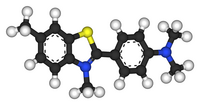This is an old revision of this page, as edited by CheMoBot (talk | contribs) at 08:52, 30 July 2011 (Updating {{chembox}} (no changed fields - added verified revid - updated 'UNII_Ref', 'ChEMBL_Ref', 'KEGG_Ref') per Chem/Drugbox validation (report errors). The present address (URL) is a permanent link to this revision, which may differ significantly from the current revision.
Revision as of 08:52, 30 July 2011 by CheMoBot (talk | contribs) (Updating {{chembox}} (no changed fields - added verified revid - updated 'UNII_Ref', 'ChEMBL_Ref', 'KEGG_Ref') per Chem/Drugbox validation (report errors)(diff) ← Previous revision | Latest revision (diff) | Newer revision → (diff) | |
| Names | |
|---|---|
| IUPAC names
4-(3,6-dimethyl-1,3-benzothiazol-3 -ium-2-yl)-N,N-dimethylaniline chloride | |
| Identifiers | |
| CAS Number | |
| 3D model (JSmol) | |
| ChEMBL | |
| ChemSpider | |
| ECHA InfoCard | 100.017.482 |
| PubChem CID | |
| CompTox Dashboard (EPA) | |
InChI
| |
SMILES
| |
| Properties | |
| Chemical formula | C17H19ClN2S |
| Molar mass | 318.86 g/mol |
| Except where otherwise noted, data are given for materials in their standard state (at 25 °C , 100 kPa).
| |
Thioflavin can refer to either of two dyes used for histology staining and biophysical studies of protein aggregation.
Thioflavin T (Basic Yellow 1 or CI 49005) is a benzothiazole salt obtained by the methylation of dehydrothiotoluidine with methanol in the presence of hydrochloric acid. The dye is widely used to visualize and quantify the presence of misfolded protein aggregates called amyloid, both in vitro and in vivo (e.g., plaques composed of amyloid beta found in the brains of Alzheimer's disease patients).
When it binds to beta sheet-rich structures, such as those in amyloid aggregates, the dye displays enhanced fluorescence and a characteristic red shift of its emission spectrum. This change in fluorescent behavior can be caused by many factors that affect the excited state charge distribution of Thioflavin T, including binding to a rigid, highly-ordered amyloid structure, or to specific chemical interactions with a protein.
Thioflavin T fluorescence is often used as a diagnostic of amyloid structure, but it is not perfectly specific for amyloid. Depending on the particular protein and experimental conditions, Thioflavin T may or may not undergo a spectroscopic change upon binding to precursor monomers, small oligomers, unaggregated material with a high beta sheet content, or even alpha helix-rich proteins. Conversely, some amyloid fibers do not affect Thioflavin T fluorescence, raising the prospect of false negative results.
 Structure of Thioflavin T bound to an amyloid-like oligomer of β2 microglobulin (in gray), in a complex that displays enhanced and red shifted fluorescence. Many factors that shift the excited state charge from the dimethylaminobenzyl portion of Thioflavin T (in blue) to the benzothiazole portion (in red), including binding to rigid, highly-ordered amyloid aggregates, can produce this 'positive' Thioflavin T signal.
Structure of Thioflavin T bound to an amyloid-like oligomer of β2 microglobulin (in gray), in a complex that displays enhanced and red shifted fluorescence. Many factors that shift the excited state charge from the dimethylaminobenzyl portion of Thioflavin T (in blue) to the benzothiazole portion (in red), including binding to rigid, highly-ordered amyloid aggregates, can produce this 'positive' Thioflavin T signal.
An article published online in Nature on 30 March 2011 showed that Thioflavin T exposure on adult C. elegans resulted "in a profoundly extended lifespan and slowed aging" at some levels, but decreased lifespan at higher levels.
Thioflavin S is a homogenous mixture of compounds that results from the methylation of dehydrothiotoluidine with sulfonic acid. It is also used to stain amyloid plaques. Like Thioflavin T it binds to amyloid fibrils but not monomers and gives a distinct spectral shift upon binding. However the dye is unable to be used in quantitative measurements of fibril solutions due to its high background fluorescence. Another dye that is used to identify amyloid structure is Congo Red.
References
- ^ H. LeVine III, Methods in Enzymology. 309, 274 (1999)
- ^ L.S. Wolfe et al., Protein-induced photophysical changes to the amyloid indicator dye thioflavin T Proc Natl Acad Sci USA 107, 16863 (2010)
- H. LeVine III, Prot. Sci. 2, 404 (1993); H. LeVine III, Amyloid Int. J. Exp. Clin. Invest. 2, 1 (1995)
- A.L. Cloe et al., The Japanese Mutant Aβ (ΔE22-Aβ1−39) Forms Fibrils Instantaneously, with Low-Thioflavin T Fluorescence: Seeding of Wild-Type Aβ1−40 into Atypical Fibrils by ΔE22-Aβ1−39 Biochemistry 50, 2026 (2011)
- Alavez S. et al, (2011). Amyloid-binding compounds maintain protein homeostasis during ageing and extend lifespan Nature
External links
This biochemistry article is a stub. You can help Misplaced Pages by expanding it. |